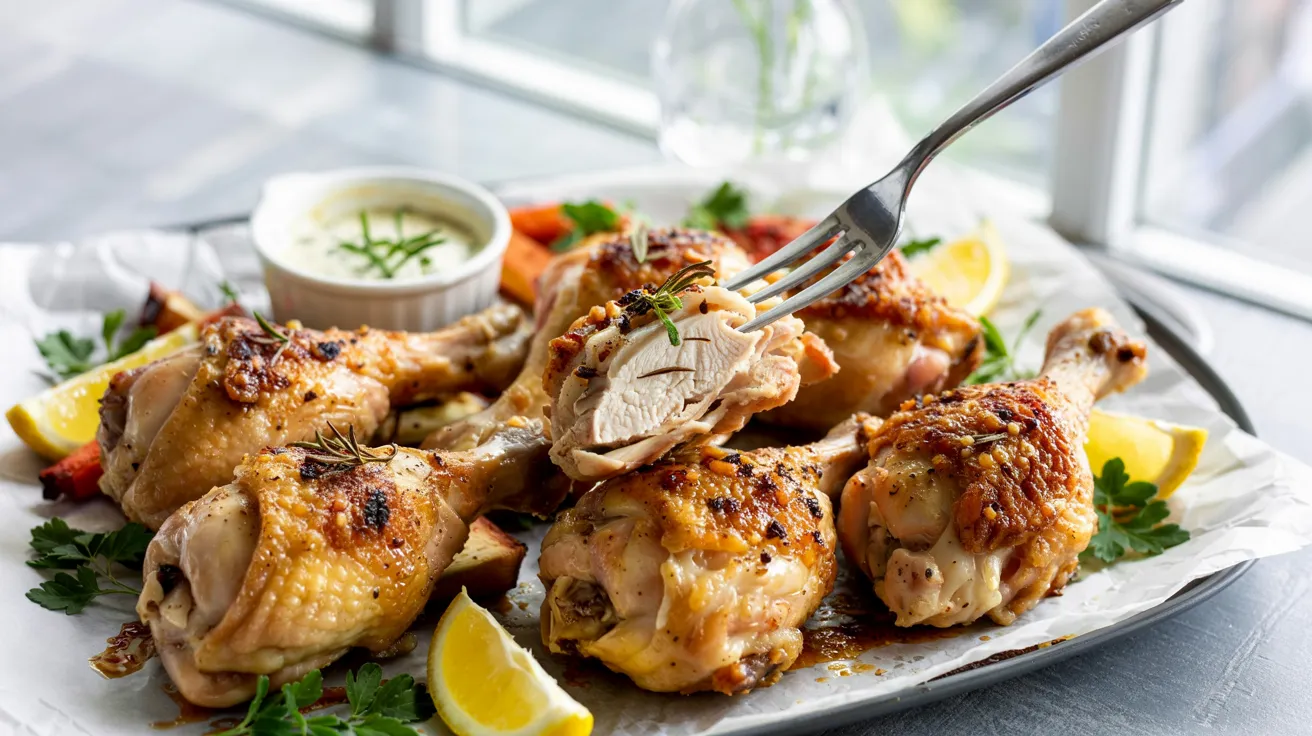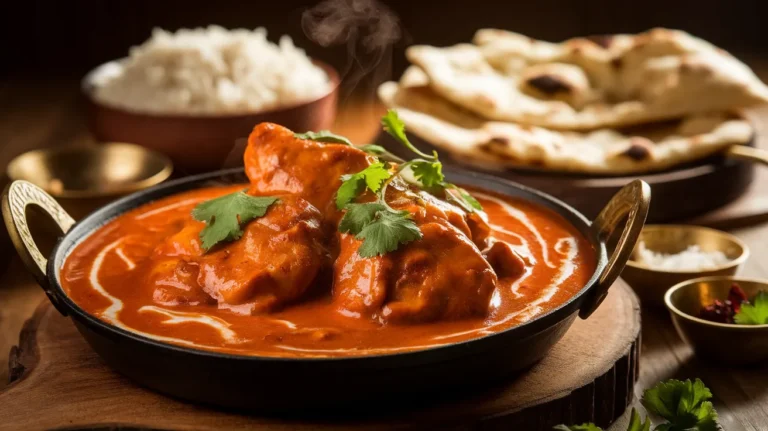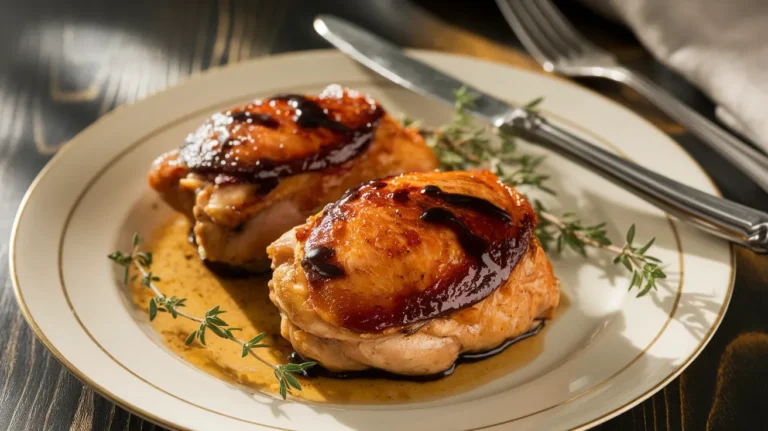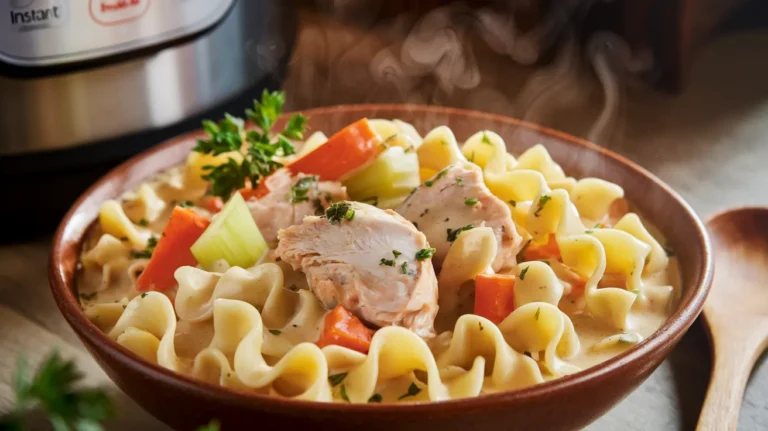Prep Time: 15 minutes | Cook Time: 45 minutes | Total Time: 1 hour | Servings: 4
- These delicious baked chicken legs turn out juicy inside with perfectly crispy skin every time
- Just 10 minutes of hands-on prep work creates a no-fuss weeknight dinner
- The secret marinade keeps meat tender and flavorful – no more dry chicken!
- Beginner-friendly recipe with fool-proof techniques for perfect results
Why These Delicious Baked Chicken Legs Never Fail
Ever stared at a package of chicken legs wondering how to transform them into something amazing without complicated steps? We’ve all been there.
Delicious baked chicken legs shouldn’t require culinary school training. This recipe solves the common problem of dry, bland chicken with a simple technique that delivers juicy, flavorful results every single time.
The magic happens with a quick marinade and the perfect oven temperature. When you bite into these delicious baked chicken legs, you’ll get that satisfying crunch from the crispy skin followed by tender, flavorful meat that practically falls off the bone.
This recipe is perfect for beginners because it’s nearly impossible to mess up. The detailed instructions will guide you through every step of the process.
Looking for more Asian-inspired chicken dishes? Try our Chicken Nanban with its tangy-sweet sauce for a completely different flavor experience!
Nutrition Facts (Per Serving)
| Nutrient | Amount | % Daily Value |
|---|---|---|
| Calories | 310 | – |
| Protein | 28g | 56% |
| Carbohydrates | 2g | <1% |
| Fat | 22g | 28% |
| Saturated Fat | 6g | 30% |
| Fiber | 0g | 0% |
| Sugar | <1g | <1% |
| Sodium | 720mg | 31% |
What You’ll Need for Delicious Baked Chicken Legs
Ingredients
| Ingredient | Quantity | Notes |
|---|---|---|
| Chicken legs | 8 (about 2 lbs) | Room temperature for even cooking |
| Olive oil | 3 tablespoons | Extra virgin preferred |
| Garlic powder | 2 teaspoons | Not garlic salt |
| Paprika | 2 teaspoons | Sweet or smoked |
| Dried oregano | 1 teaspoon | May substitute Italian seasoning |
| Salt | 1½ teaspoons | Kosher salt preferred |
| Black pepper | 1 teaspoon | Freshly ground |
| Lemon | 1 | For juice and optional garnish |
| Fresh parsley | 2 tablespoons | Chopped, for garnish (optional) |
Kitchen Tools
| Tool | Purpose |
|---|---|
| Baking sheet | Large enough for 8 chicken legs without crowding |
| Wire rack (optional) | For extra crispy skin |
| Aluminum foil | For easier cleanup |
| Mixing bowl | Medium-sized for the marinade |
| Measuring spoons | For precise seasoning |
| Meat thermometer | To check doneness |
| Tongs | For flipping the chicken |
| Paper towels | For drying chicken |
| Kitchen scissors | For trimming (optional) |
| Small whisk | For mixing marinade |
Ingredient Substitutions
- Chicken legs: Thighs work well with the same cooking time
- Olive oil: Avocado oil or melted butter make good alternatives
- Dried herbs: Fresh herbs work too (use 3x the amount)
- Lemon: Lime or orange for a different citrus flavor
- Garlic powder: 4 fresh minced garlic cloves
If you’re looking for a stir-fry option instead, our Chicken with Garlic Sauce offers bold flavors with similar ingredients!
Super-Detailed Step-by-Step Instructions
Preparation Phase (15 minutes)
- Set up your workspace:
- Clear your countertop and wash your hands thoroughly with soap and warm water
- Take out all ingredients and tools so everything is within reach
- Check that you have enough aluminum foil to cover your baking sheet completely
- Preheat your oven:
- Turn your oven on to 425°F (220°C)
- This higher temperature is key for getting crispy skin
- Allow at least 10-15 minutes for the oven to fully preheat
- If your oven has a “convection” setting, use it for even crispier results
- Prepare your baking sheet:
- Take your large baking sheet and unroll aluminum foil
- Cut a piece large enough to cover the entire sheet with some overhang
- Press the foil down to fit the contours of the baking sheet
- If using a wire rack, place it on top of the foil now
- Spray lightly with cooking spray (or brush with thin layer of oil)
- If you don’t have a wire rack, don’t worry – the chicken will still turn out great
- Prepare the chicken legs:
- Remove chicken from packaging (discard packaging immediately)
- Take a stack of paper towels (3-4 sheets)
- Pat each chicken leg thoroughly on all sides until completely dry
- This step is CRITICAL for crispy skin – don’t skip it!
- If you see any loose bits of skin or large chunks of fat, trim them with kitchen scissors
- Place dried chicken on a clean plate
- Let chicken come to room temperature:
- Leave the patted-dry chicken on the counter for 15 minutes
- This ensures even cooking (cold chicken can cook unevenly)
- Use this time to prepare your marinade
- Make the marinade:
- Get a medium-sized mixing bowl
- Add 3 tablespoons olive oil to the bowl
- Measure and add all dry seasonings: 2 teaspoons garlic powder, 2 teaspoons paprika, 1 teaspoon oregano, 1½ teaspoons salt, and 1 teaspoon black pepper
- Cut your lemon in half
- Squeeze juice from ONE HALF of the lemon into the bowl (about 1-2 tablespoons)
- Save the other lemon half for later
- Use a small whisk or fork to mix everything thoroughly (should look like a reddish-brown oil mixture)
- Taste a tiny amount on your finger – it should taste fairly salty (this is correct)
Assembly Steps (10 minutes)
- Coat the chicken with marinade:
- Check that the chicken has been sitting out for at least 15 minutes
- Place all chicken legs into the bowl with the marinade
- Using your hands (wear disposable gloves if preferred), massage the marinade into every part of the chicken
- BEGINNER TIP: Lift the skin slightly without detaching it and push some marinade underneath
- Make sure every piece is fully coated on all sides
- Let the chicken sit in the marinade for at least 5 minutes
- If you have time, you can cover the bowl and refrigerate for up to 24 hours for more flavor
- Arrange chicken for baking:
- Take each chicken leg and place it on the prepared baking sheet
- Position all pieces skin side UP
- Leave at least 1 inch of space between each piece
- BEGINNER TIP: Make sure the thickest parts of the legs are toward the outside edges of the pan
- Drizzle any remaining marinade from the bowl over the chicken pieces
- Wash your hands thoroughly after handling raw chicken
Cooking Phase (45 minutes)
- Put chicken in the oven:
- Check that your oven has preheated to 425°F
- Open the oven door fully and carefully slide the baking sheet onto the middle rack
- Close the oven door completely
- Set a timer for 35 minutes
- IMPORTANT: Do not open the oven door during this time (keeps heat consistent)
- Check for doneness:
- When timer goes off, open oven door and carefully pull rack out slightly
- If you have a meat thermometer, insert it into the thickest part of the largest chicken leg
- Make sure the thermometer doesn’t touch the bone (gives false readings)
- Chicken is done when it reaches 165°F (74°C)
- If you don’t have a thermometer, cut into the thickest part – meat should be opaque with no pink, and juices should run clear
- If chicken isn’t done, return to oven for 5 more minutes and check again
- Crisp the skin (optional but recommended):
- Once chicken has reached 165°F, switch oven to broil setting (high)
- BEGINNER TIP: Watch the chicken constantly during this step!
- Broil for 2-3 minutes until skin is golden and crispy
- Remove immediately if you see any spots getting too dark
Finishing Steps (5 minutes)
- Rest the chicken:
- Use tongs to remove baking sheet from oven
- Place baking sheet on a heat-safe surface
- Let chicken rest for 5 minutes (this keeps meat juicy)
- Take the remaining lemon half and squeeze juice over the hot chicken
- BEGINNER TIP: Use a fork to hold the lemon half to avoid burning your fingers
- Garnish and serve:
- If using fresh parsley, sprinkle it over the chicken now
- Use tongs to transfer 2 legs per person onto dinner plates
- These delicious baked chicken legs pair perfectly with roasted vegetables, rice, or a simple salad
- Serve while still hot for best flavor and texture
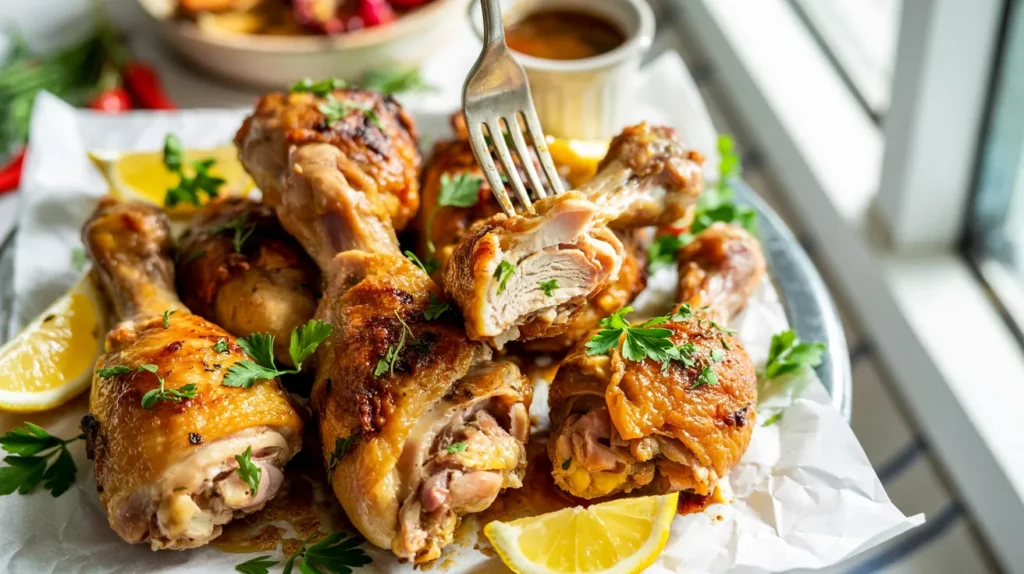
Troubleshooting Your Delicious Baked Chicken Legs
Common Problems and Solutions
- Skin not crispy enough?
- CAUSE: Chicken wasn’t patted dry enough before adding marinade
- SOLUTION: Next time, use more paper towels and dry more thoroughly
- QUICK FIX: Broil for an additional 1-2 minutes (watch carefully)
- Chicken taking too long to cook?
- CAUSE #1: Chicken pieces might be unusually large
- SOLUTION: Allow extra 5-10 minutes cooking time for larger pieces
- CAUSE #2: Chicken was too cold when it went in the oven
- SOLUTION: Always let chicken sit at room temp for 15-20 minutes first
- Outside burning but inside not done?
- CAUSE: Oven temperature too high or uneven
- SOLUTION: Lower temperature to 375°F and cook longer
- QUICK FIX: Cover partially with foil, shiny side out
- Flavors too bland?
- CAUSE #1: Not enough seasoning
- SOLUTION: Double-check measurements, don’t be afraid of salt
- CAUSE #2: Not enough marinating time
- SOLUTION: Marinate longer (overnight in refrigerator is best)
- QUICK FIX: Add more salt and extra squeeze of lemon at serving time
Variations for Your Delicious Baked Chicken Legs
Different Flavor Profiles
- BBQ Style Delicious Baked Chicken Legs:
- Replace half the olive oil with your favorite BBQ sauce
- Add 1 teaspoon each of brown sugar and smoked paprika
- Brush with additional BBQ sauce during the last 5 minutes of cooking
- Lemon Herb Delicious Baked Chicken Legs:
- Add zest from one whole lemon to the marinade
- Include 1 tablespoon each of fresh chopped rosemary and thyme
- Double the lemon juice for extra citrus punch
- Spicy Kick Delicious Baked Chicken Legs:
- Add 1 teaspoon cayenne pepper and ½ teaspoon red pepper flakes
- Include 1 tablespoon honey for sweet heat balance
- Serve with cooling yogurt sauce on the side
- Asian-Inspired Delicious Baked Chicken Legs:
- Replace lemon with lime juice
- Add 1 tablespoon soy sauce and 1 teaspoon ginger powder
- Garnish with sliced green onions and sesame seeds
If you love Asian flavors, our Garlic Chicken Lo Mein makes a perfect companion dish to these baked chicken legs!
Storage & Reheating
Proper Storage
- Refrigerator:
- Allow chicken to cool completely (no more than 2 hours at room temperature)
- Place in airtight container with lid
- Store for up to 3 days
- BEGINNER TIP: Write the date on the container with a marker
- Freezer:
- Cool chicken completely
- Wrap each piece individually in plastic wrap
- Place wrapped pieces in freezer-safe ziplock bags
- Press out all air before sealing
- Label with date and contents
- Store for up to 3 months
Best Reheating Methods
- Oven Method (best for crispy skin):
- Preheat oven to 350°F
- Place chicken on a wire rack over a baking sheet
- Lightly cover with foil (shiny side in)
- Reheat for 15-20 minutes
- Remove foil for last 5 minutes to re-crisp skin
- Check that internal temperature reaches 165°F
- Air Fryer Method:
- Preheat air fryer to 370°F
- Place chicken legs in basket with space between pieces
- Reheat for 5-7 minutes
- Check halfway through and flip if needed
- BEGINNER TIP: Spritz with a little oil for extra crispiness
- Microwave Method (quickest but skin won’t be crispy):
- Place chicken on a microwave-safe plate
- Cover with a damp paper towel
- Heat on 70% power for 2 minutes
- Check temperature and continue in 30-second intervals until hot
- Let stand for 1 minute before serving
Safety Notes & Tips
Food Safety for Beginners
- Always wash hands with soap and warm water for 20 seconds before and after handling raw chicken
- Never place cooked food on surfaces that held raw chicken
- Use separate cutting boards for meat and vegetables
- Sanitize countertops and tools that touched raw chicken with diluted bleach solution or disinfectant
- Never reuse marinades that have touched raw chicken
- Chicken must reach 165°F internal temperature to be safe to eat
- Refrigerate leftovers within 2 hours of cooking (1 hour if room temperature is above 90°F)
- When in doubt, throw it out – never risk eating chicken that smells off or has been improperly stored
Pro Tips for Perfect Delicious Baked Chicken Legs
- For the juiciest chicken: Try brining the legs in salt water (2 tablespoons salt per quart) for 1 hour before starting the recipe
- For even cooking: Don’t skip the step of letting chicken come to room temperature
- For meal prep: Double the recipe and freeze half for an easy future dinner
- For less mess: Line the baking sheet with parchment paper instead of foil for even easier cleanup
- For crispy bottom skin: Flip chicken halfway through cooking (but this is optional)
- For extra flavor: Add a teaspoon of your favorite spice blend to the marinade
- For a complete meal: Add vegetables like potato chunks, carrots, and onions around the chicken during the last 20 minutes of cooking
